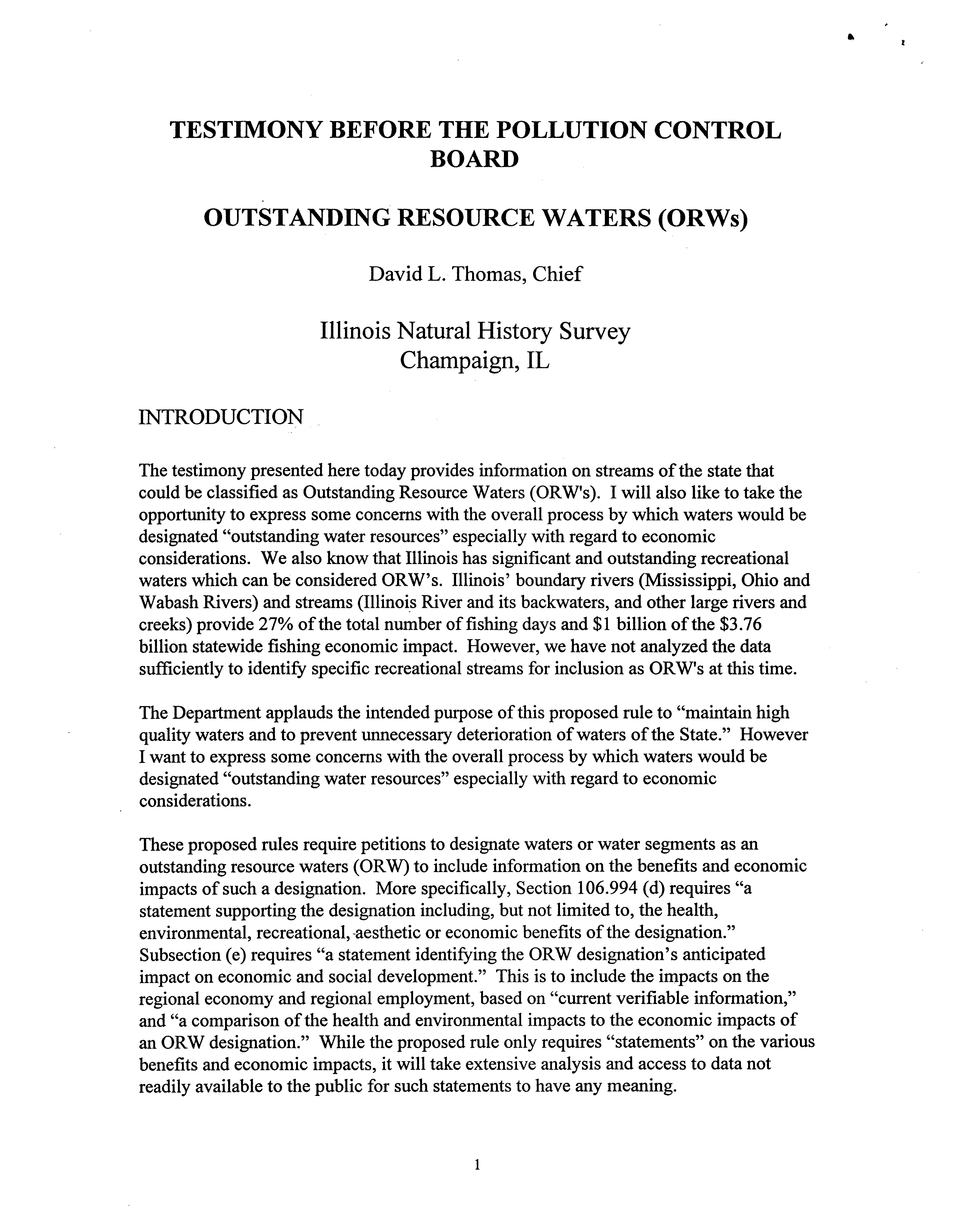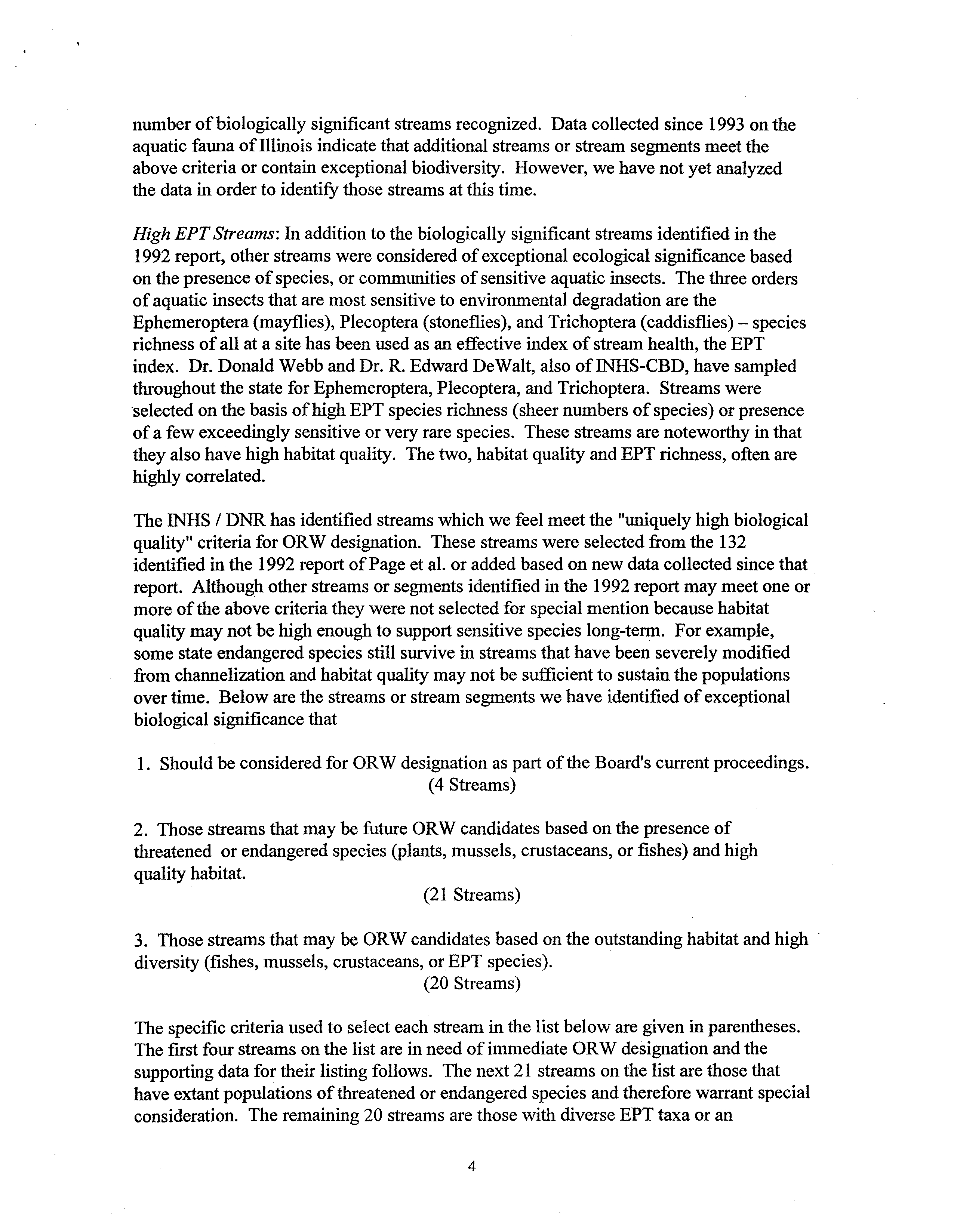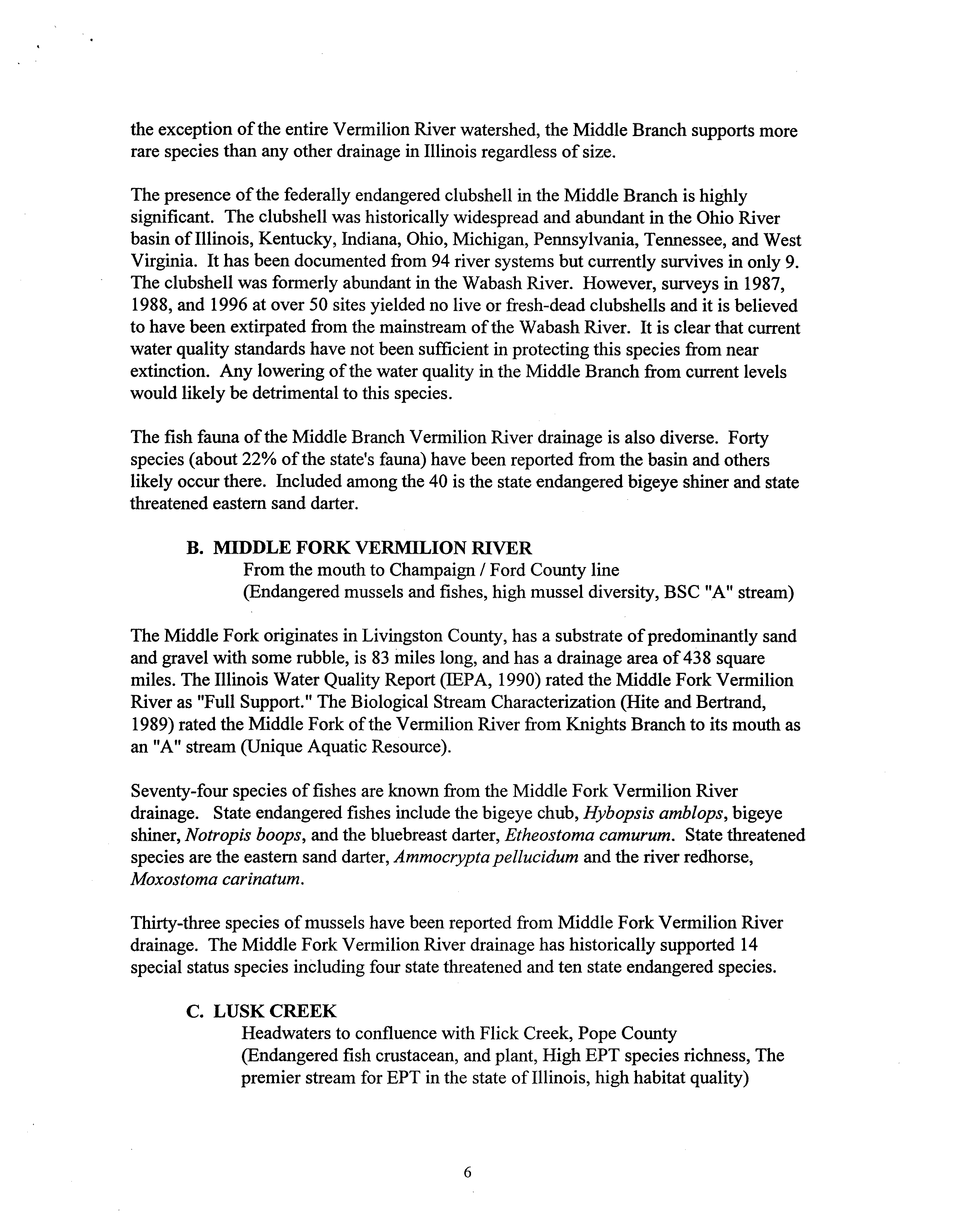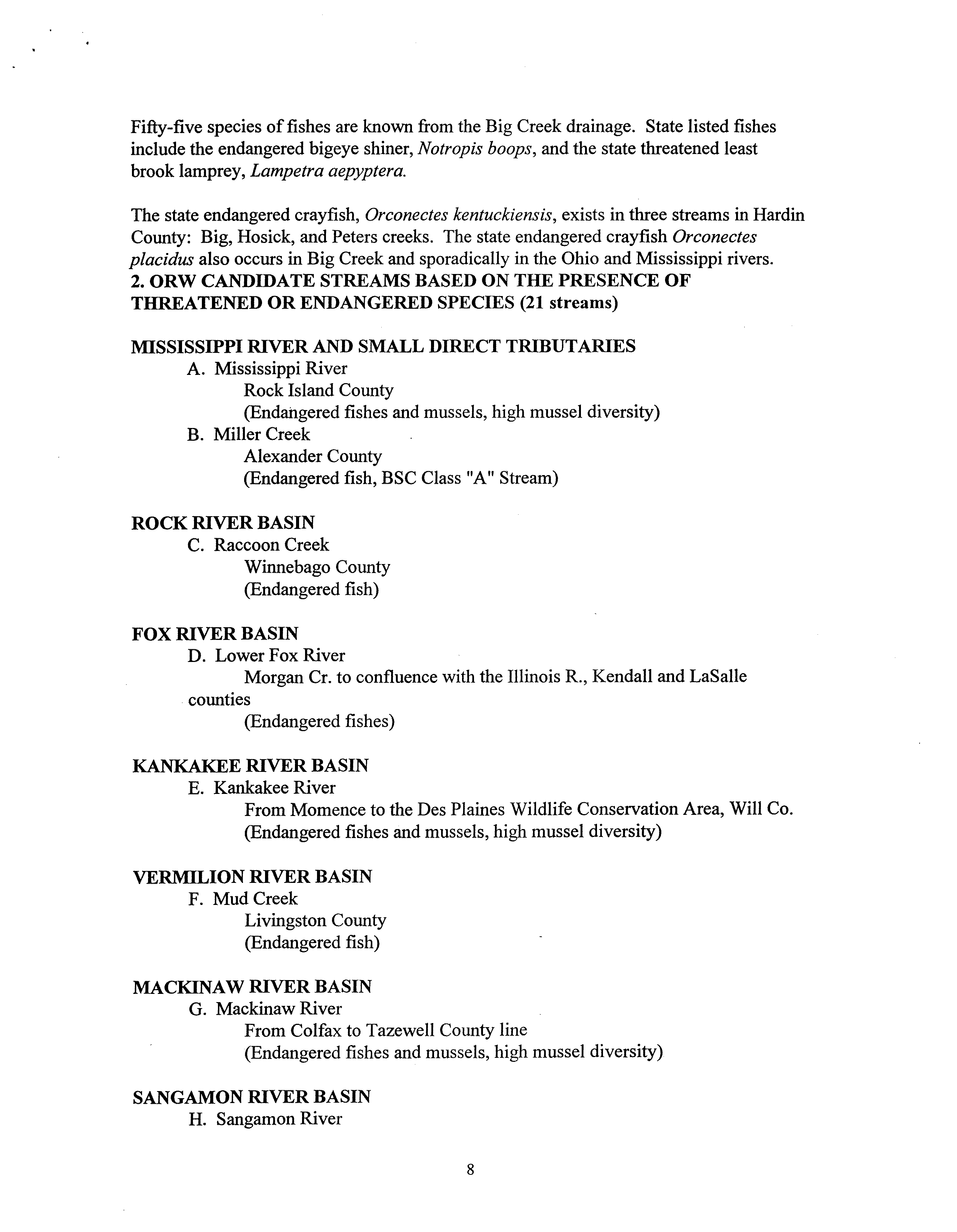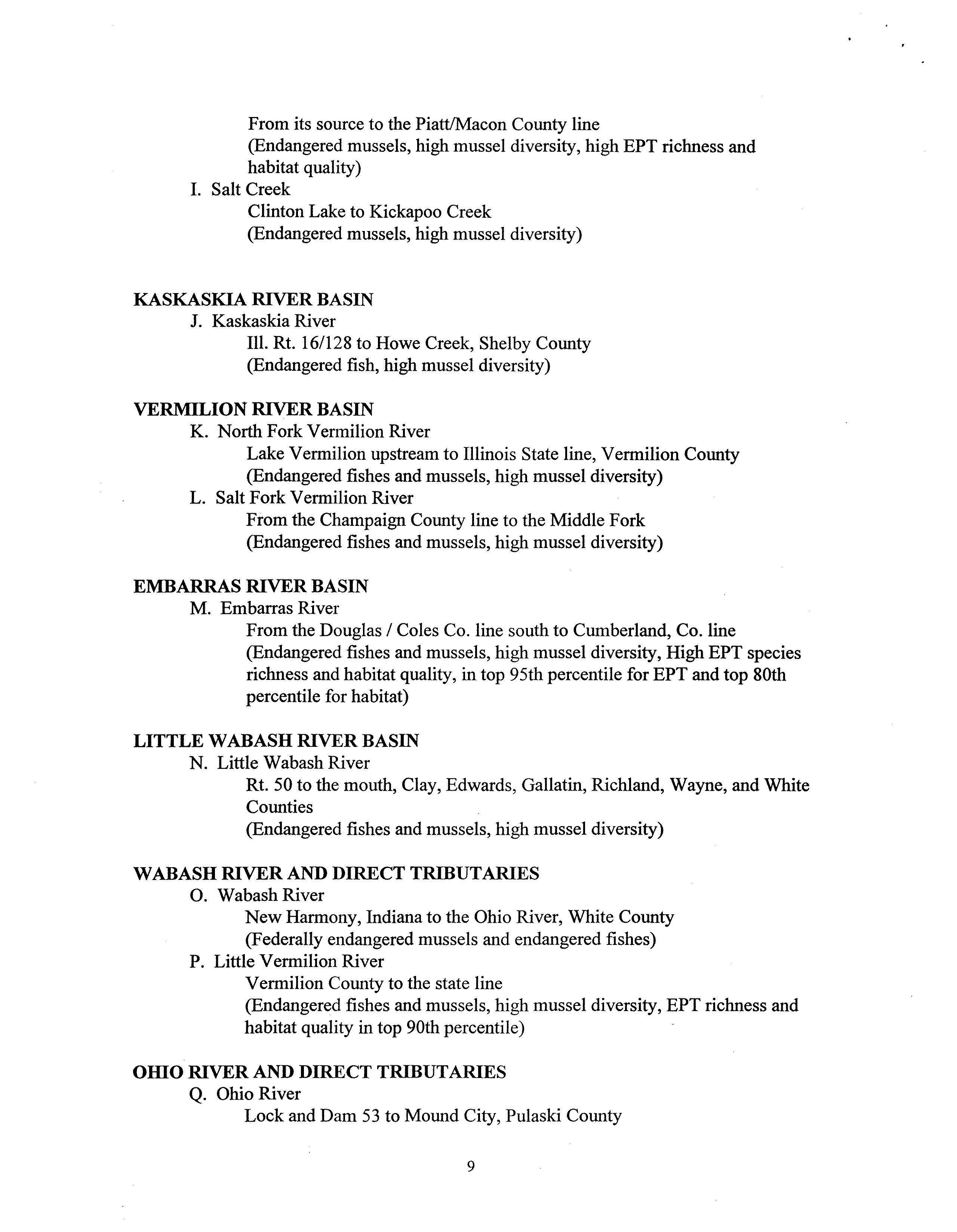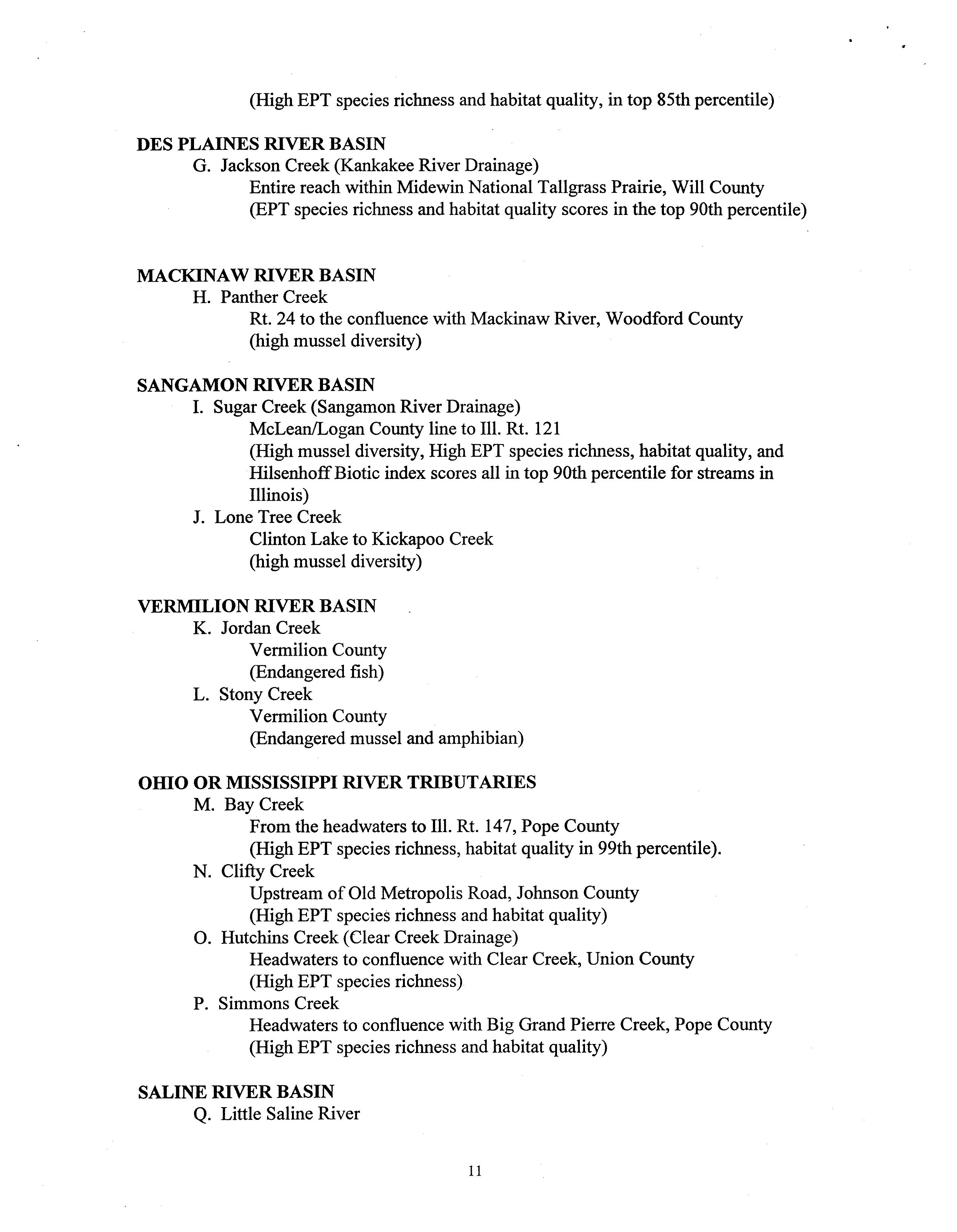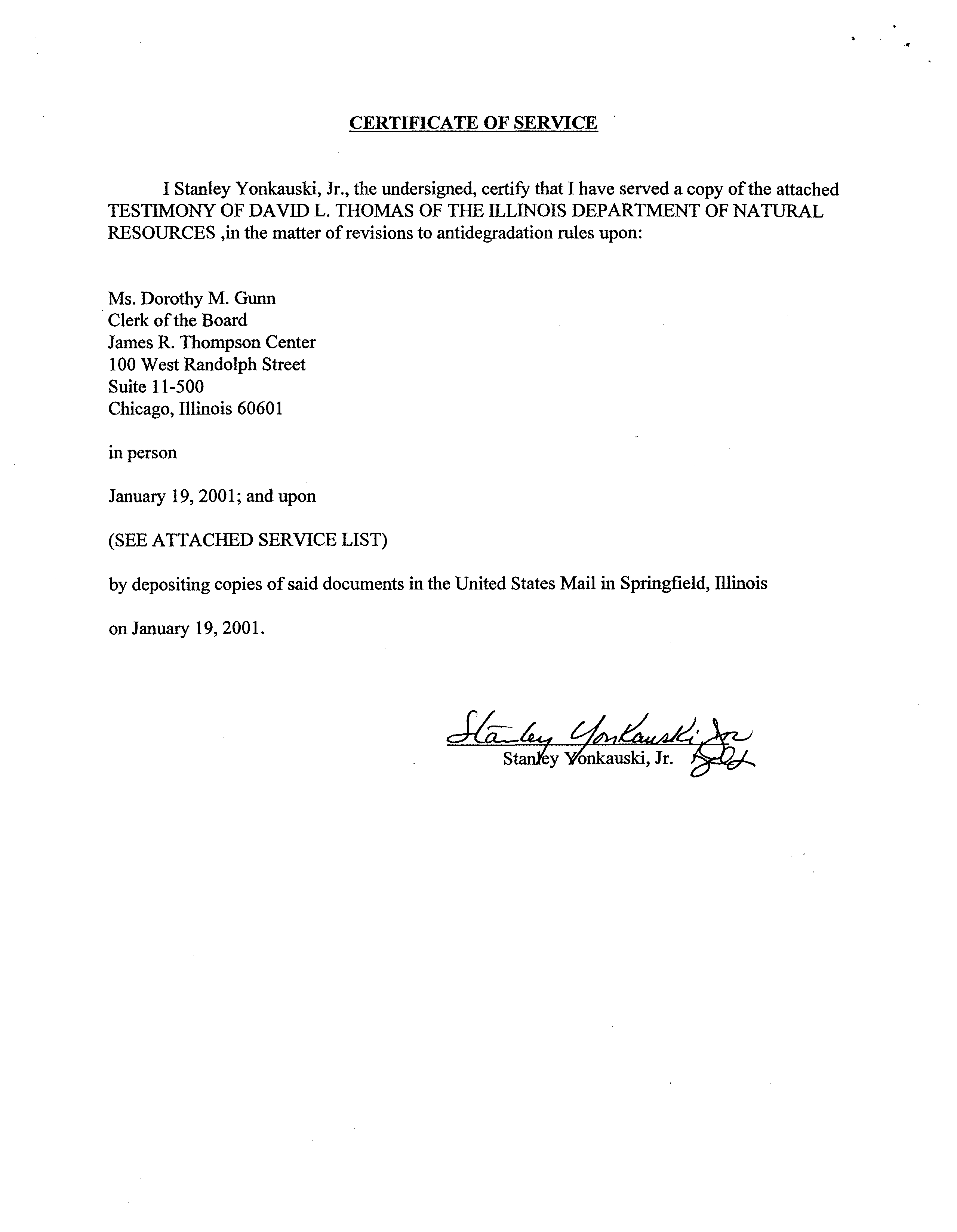4
E
C E !
tiE fl
CLERK’S OFFICE
J1~N
192001
IN THE MATTER OF:
REVISIONS TO ANTIDEGRADATION
RULES. 35 ILL.ADM. CODE 302.105, 303.206,
AND 106.990-106. 995.
)
)
)
R01-13
)
)
STATE
OF ILLINOIS
Polluti0~
Control
Board
NOTICE
OF
FILING
TO:
Ms. Dorothy M. Gunn
Clerk ofthe Board
Illinois Pollution Control Board
James R. Thompson Center
100 West Randolph Street
Suite 11-500
Chicago, Illinois 60601
(PERSONS ON ATTACHED SERVICE LIST)
Marie Tipsord, Esq.
Attorney
Illinois Pollution Control Board
James R. Thompson Center
100 West Randolph Street
Suite 11-500
Chicago, Illinois 60601
PLEASE TAKE NOTICE that I have filed today with the Clerk ofthe Illinois Pollution
Control Board an original and nine copies ofthe TESTIMONY OF DAVID L. THOMAS OF
THE ILLINOIS DEPARTMENT OF NATURAL RESOURCES, ON THE ABOVE
CAPTIONED MATTER, copies ofwhich are herewith served upon you.
January 19, 2001
Stanley Yonkauski, Jr.
Legal Counsel
Illinois Department ofNatural Resources
524
South Second Street, LTP
Springfield, Illinois 62701-1787
(217) 782-1809
Respectfully submitted,
ILLiNOIS DEPARTMENT OF
NATURAL RESOURCES,
By:
~
One ofIjlA/~orneys
BEFORE THE ILLINOIS POLLUTION CONTROL BOARD
TESTIMONY BEFORE THE POLLUTION CONTROL
BOARD
OUTSTANDING RESOURCE WATERS (ORWs)
David L. Thomas, Chief
Illinois Natural History Survey
Champaign, IL
INTRODUCTION
The testimony presentedhere today provides information on streams ofthe state that
could be classified as Outstanding Resource Waters (ORW’s). I will also like to take the
opportunity to express some concerns with the overall process by which waters would be
designated “outstanding water resources” especially with regard to economic
considerations. We also knowthat Illinois has significant and outstanding recreational
waters which can be considered ORW’s. Illinois’ boundary rivers (Mississippi, Ohio and
Wabash Rivers) and streams (Illinois River and its backwaters, and other large rivers and
creeks) provide 27 ofthe total number of fishing days and $1 billion ofthe $3.76
billion statewide fishing economic impact. However, we have not analyzed the data
sufficiently to identify specific recreational streams for inclusion as ORW’s at this time.
The Department applauds the intended purpose ofthis proposed rule to “maintain high
quality waters and to prevent unnecessary deterioration ofwaters ofthe State.” However
I want to express some concerns with the overall process by which waters would be
designated “outstanding water resources” especially with regard to economic
considerations.
These proposed rules require petitions to designate waters or water segments as an
outstanding resource waters (ORW) to include information on the benefits and economic
impacts ofsuch a designation. More specifically, Section 106.994 (d) requires “a
statement supporting the designation including, but not limited to, the health,
environmental, recreational, -aesthetic or economic benefits ofthe designation.”
Subsection (e) requires “a statement identifying the ORW designation’s anticipated
impact on economic and social development.” This is to include the impacts on the
regional economy and regional employment, based on “current verifiable information,”
and “a comparison ofthe health and environmental impacts to the economic impacts of
an ORW designation.” While the proposed rule only requires “statements” on the various
benefits and economic impacts, it will take extensive analysis and access to data not
readily available to the public for such statements to have any meaning.
1
The economic impact side ofthe ORW designation needs to include at a minimum; cost
figures, changes in income, changes in revenue, changes in employment, impacts on
different economic sectors, and impacts on local government such as infrastructure and
revenue. The prediction offuture economic opportunities is highly subjective, which will
result in challenges to whateverthe results are ofthe economic statements provided by a
petitioner.
An examination ofthe benefits ofan ORW designation would entail site specific studies
and surveys on the value ofdifficult to calculate benefits such as aesthetic,
environmental, recreational, and health. Such studies take significant resources to
complete and even then there can be strong disagreements on the validity ofsuch analysis
in a hearing before the Pollution Control Board. Consequently, this can be a burdensome
process for individuals and organizations that want to petition forORW designation,
requiring extensive technical and legal support for each ORWdesignation petition.
Designation ofan ORW should be based on water quality, biological criteria and
significant recreational resources; adding an economic analysis requirement may make it
impossible to designate an ORW.
The identification ofstreams of “exceptional ecological significance” is based on
extensive biological collections made over many years by the Illinois Natural History
Survey (INHS). A 1992 report listed 132 steams or stream segments as biologically
significant (cited below). Additional streams meeting the criteria for listing as
biologically significant have been identified from data collected since the publication of
the 1992 report. Also some ofthe streams identified in the 1992 report no longer meet
the criteria and will be downgraded. Working from the 1992 list, we added new
information obtained since the publication ofthe report, and identified a subset of45
streams or stream segments ofexceptional ecological significance. Within the list of45
streams or stream segments we have identified 25 that warrant special attention because
theyharbor extant populations ofthreatened and endangered species.
We are not prepared at this time to make the case called for in the proposed rules for
ORW designation ofall 45 streams or stream segments that we have identified with
threatened and endangered species or high quality habitat, we do feel that these streams
deserve some extra protection from the state. Some ofthe T&E species could be
threatened by waters that just meet water quality standards. Based on data related to
changes in the distribution and abundance ofsome ofour state’s threatened and
endangered species, populations are disappearing from our waters. It therefore appears
that ORW designation may be necessary to maintain these populations.
We have identified below four streams that we believe need immediate protection
afforded by designation as ORW’s. These include the Middle Branch North Fork
Vermilion River Drainage, the Middle Fork Vermilion River (which runs through state
land for much ofits length and is Illinois’ only nationally designated wild and scenic
river), Lusk Creek, and Big Creek (both ofwhich are in the Shawnee National Forest).
All four ofthe streams have state endangered species and the Middle Branch North Fork
2
also has a federally endangered mussel. Based Upon our review, we know ofno current
discharges with NPDES permits in these streams segments.
Below is a more detailed description ofthe four streams we are proposing for immediate
ORW designation plus a list of41 streams or stream segments (culled from the larger list
ofbiologically significant streams and others with high biodiversity) that may warrant
listing as ORW’s in the future.
ILLINOIS STREAMS IN NEED OF PROTECTION
In drafting the present list of streams we drew from two data sets: the Biologically
Significant Streams Report (Page et al. 1992) (a copy ofthis report is attached to this
testimony) and an EPT index, both ofwhich are discussed below.
BiologicallySign~fIcantStreams:
Illinois has over 2700 named streams that make up
more than 26,000 miles ofinland watercourses. In 1992, biologists from the Center for
Biodiversity ofthe Illinois Natural History Survey published a report entitled
Biologically
Sign~flcantillinois Streams: An Evaluation ofthe streams ofillinois basedon Aquatic
Biodiversity
(Page et al. 1992). The objective ofthe study was to identify the state’s most
biologically significant streams so that protection efforts could be concentrated on a
manageable number ofstreams. The report was designed to supplement an earlier and
continuing study to identify high quality streams called the
Biological Stream
Characterization
or BSC. The BSC is a stream-quality index developed by the Illinois
Department ofNatural Resources and Illinois Environmental Protection Agency to
categorize streams based largely upon fish populations, water quality, and selected
aquatic macroinvertebrates.
In the Biologically Significant Streams report, data on freshwater mussel diversity and
threatened and endangered species were used to expand the list of streams identified by
the BSC as those most important to protect and manage-for their outstanding biological
characteristics. Those sites in common or overlapping in the Biologically Significant
Streams study and the BSC rank among the best in Illinois. The specific criteria used to
identify biologically significant streams were:
1. Streams that supported populations of federal or state watch list, threatened or
endangered species ofplants, mussels, crustaceans, or fishes.
2. Streams with high mussel diversity. High diversity mussel streams or stream
segments were defmed as those with more than ten live species or those with a
Shannon-Weaver Diversity index greater than
2.5.
The use ofmussel diversity was
limited to only those streams where we had recent (post-1976) data (Kaskaskia,
Kankakee, Sangamon, Mackinaw, Vermilion, Embarras, Little Wabash, and Wabash
rivers).
One hundred and eight streams that met the above criteria were identified. These streams
plus the 24 streams identified as “A” streams in the BSC classification brought to 132 the
3
number of biologically significant streams recognized. Data collected since 1993 on the
aquatic fauna ofIllinois indicate that additional streams or stream segments meet the
above criteria or contain exceptional biodiversity. However, we have not yet analyzed
the data in order to identify those streams at this time.
High EPT Streams:
In addition to the biologically significant streams identified in the
1992 report, other streams were considered ofexceptional ecological significance based
on the presence ofspecies, or communities of sensitive aquatic insects. The three orders
of aquatic insects that are most sensitive to environmental degradation are the
Ephemeroptera (mayflies), Plecoptera (stoneflies), and Trichoptera (caddisflies)
—
species
richness ofall at a site has been used as an effective index ofstream health, the EPT
index. Dr. Donald Webb and Dr. R. Edward DeWalt, also ofINHS-CBD, have sampled
throughout the state forEphemeroptera, Plecoptera, and Trichoptera. Streams were
selected on the basis ofhigh EPT species richness (sheer numbers ofspecies) or presence
ofa few exceedingly sensitive or very rare species. These streams are noteworthy in that
they also have high habitat quality. The two, habitat quality and EPT richness, often are
highly correlated.
The INNS / DNR has identified streams which we feel meet the “uniquely high biological
quality” criteria for ORW designation. These streams were selected from the 132
identified in the 1992 report ofPage et al. or added based on new data collected since that
report. Although other streams or segments identified in the 1992 report may meet one or
more ofthe above criteria they were not selected for special mention because habitat
quality may not be high enough to support sensitive species long-term. For example,
some state endangered species still survive in streams that have been severely modified
from channelization and habitat quality may not be sufficient to sustain the populations
over time. Below are the streams or stream segments we have identified ofexceptional
biological significance that
1. Should be considered for ORW designation as part ofthe Board’s current proceedings.
(4 Streams)
2. Those streams that may be future ORW candidates based on the presence of
threatened or endangered species (plants, mussels, crustaceans, or fishes) and high
quality habitat.
(21 Streams)
3. Those streams that may be ORW candidates based on the outstanding habitat and high
-
diversity (fishes, mussels, crustaceans, or EPT species).
(20 Streams)
The specific criteria used to select each stream in the list below are given in parentheses.
The first four streams on the list are in need ofimmediate ORW designation and the
supporting data for their listing follows. The next 21 streams on the list are those that
have extant populations ofthreatened or endangered species and therefore warrant special
consideration. The remaining 20 streams are those with diverse EPT taxa or an
4
exceptionally high diversity ofmussels, crustaceans or fishes. The list begins with
streams in the northern part ofIllinois and generally proceeds to the south. Additional
data, from the BSC or other sources, may result in some modifications ofthe list;
however, all ofthese streams remain highly biologically significant and should be
protected from degradation.
1.
STREAMS
PROPOSED FOR
IMMEDIATE
ORW DESIGNATION (4
streams)
Below are the four streams we are proposing for inclusion in Section 303 .206 (list of
Outstanding Resource Waters).
A.
MIDDLE BRANCH
NORTH
FORK VERMILION RWER DRAINAGE
(Federally endangered mussel; state threatened and endangered fishes and
mussels; high mussel diversity)
Based on historical occurrences, the North Fork Vermilion River supported more state
threatened or endangered species than any other stream in Illinois (Illinois Endangered
Species Protection Board. 1993. Highest priority streams/lakes forthe conservation of
aquatic endangered and threatened species in Illinois. Springfield, Illinois. 7 pp.).
Freshwater mussels have been decimated throughout the eastern United States and may
be the most endangered group ofanimals in North America. Records from the Illinois
Natural History Survey indicate that the North Fork Vermilion River drainage historically
supported a diverse mussel fauna of at least 30 species, over a third (12) ofwhich are
currently threatened or endangered. The only remaining Illinois populations ofthe
federally endangered clubshell
(Pleurobema clava)
and the state endangered rainbow
(Villosa iris)
survive in the North Fork. The river also likely supports the last
reproducing populations ofthe state endangered rabbitsfoot
(Quadrula cylindrica)
and
purple lilliput
(Toxolasma lividus)
in Illinois. Additionally, the state endangered eastern
sand darter
(Ammoctyptapellucida)
and bigeye shiner
(Notropis boops)
occur in the
North Fork.
In terms ofwater quality, the Illinois Environmental Protection Agency (1996) rated the
North Fork Vermilion River as “Full Use Support” and the Biological Streams
Characterization rated the North Fork from the Illinois-Indiana state line to Panther Creek
and from Lake Vermilion to the Vermilion River as a “B” Stream (Highly Valued
Aquatic Resource). The North Fork Vermilion River from Lake Vermilion upstream to
the Illinois State line has been classified a Biologically Significant Stream in Illinois.
The Middle Branch is the largest tributary ofthe North Fork Vermilion River. The
Middle Branch is 17.3 miles (27.8 1cm) in length and drains an area of43 mi2
(57
km2) in
Illinois. A survey ofthe mussel fauna ofthe Middle Branch was conducted in 1996-98.
In that survey 22 ofthe 30 known species from the North Fork drainage were found alive
including one federally endangered, five state endangered and two state threatened
species. Based on comparisons with other Illinois drainages, the Middle Branch supports
one ofthe most diverse mussel faunas in Illinois. Species richness is comparable to other
basins with much larger drainage area. By way ofcomparison the Middle Branch
supports only 4 fewer mussel species than the ENTIRE Illinois River mainstream. With
5
the exception ofthe entire Vermilion River watershed, the Middle Branch supports more
rare species than any other drainage in Illinois regardless ofsize.
The presence ofthe federally endangered clubshell in the Middle Branch is highly
significant. The clubshell was historically widespread and abundant in the Ohio River
basin ofIllinois, Kentucky, Indiana, Ohio, Michigan, Pennsylvania, Tennessee, and West
Virginia. It has been documented from 94 river systems but currently survives in only 9.
The clubshell was formerly abundant in the Wabash River. However, surveys in 1987,
1988, and 1996 at over 50 sites yielded no live or fresh-dead clubshells and it is believed
to have been extirpated from the mainstream ofthe Wabash River. It is clear that current
water quality standards have not been sufficient in protecting this species from near
extinction. Any lowering ofthe water quality in the Middle Branch from current levels
would likely be detrimental to this species.
The fish fauna ofthe MiddleBranch Vermilion River drainage is also diverse. Forty
species (about 22 ofthe state’s fauna) have been reported from the basin and others
likely occur there. Included among the 40 is the state endangered bigeye shiner and state
threatened eastern sand darter.
B. MIDDLE FORK VERMILION RIVER
From the mouth to Champaign / Ford County line
(Endangered mussels and fishes, high mussel diversity, BSC “A” stream)
The Middle Fork originates in Livingston County, has a substrate ofpredominantly sand
and gravel with some rubble, is 83 miles long, and has a drainage area of 438 square
miles. The Illinois Water Quality Report (IEPA, 1990) rated the Middle Fork Vermilion
River as “Full Support.” The Biological Stream Characterization (Hite and Bertrand,
1989) rated the Middle Fork ofthe Vermilion River from Knights Branch to its mouth as
an “A” stream (Unique Aquatic Resource).
Seventy-four species offishes are known from the Middle Fork Vermilion River
drainage. State endangered fishes include the bigeye chub,
Hybopsis amblops,
bigeye
shiner,
Notropis boops,
and the bluebreast darter,
Etheostoma camurum.
State threatened
species are the eastern sand darter,
Ammocryptapellucidum
and the river redhorse,
Moxostoma carinatum.
Thirty-three species ofmussels have been reported from Middle Fork Vermilion River
drainage. The Middle Fork Vermilion River drainage has historically supported 14
special status species including four state threatened and ten state endangered species.
C. LUSK CREEK
Headwaters to confluence with Flick Creek, Pope County
(Endangered fish crustacean, and plant, High EPT species richness, The
premier stream for EPT in the state ofIllinois, high habitat quality)
6
Lusk Creek rises near Delwood, drains 88 square miles ofnortheastern Pope County, and
empties into the Ohio River at Golconda. Lusk Creek is 25 miles in length and averages
23 feet wide. The stream has cut through massive sandstone, carving a canyon with cliffs
that vary from only a few feet to nearly 100 feethigh. The creek is shallow in some areas
and flows swiftly around numerous rock and gravelly riffles. In other areas the water is
deep and forms quiet pools. Lusk Creek is one ofthe more aesthetic streams in Illinois.
Inthe Illinois Water Quality Report (IEPA, 1990) rated Lusk Creek as “Full Support.”
The Biological Stream Characterization rated Lusk Creek from Little Lusk Creek to
MansonFork as an “A” Stream (Unique Aquatic Resource). Smith (1971) rated Lusk, and
Big creeks as “Excellent” to “Good” with Big Creek and Lusk Creek as the “Outstanding”
streams in southern Illinois
Lusk Creek is a rocky, spring-fed stream traversing wooded uplands. Springs and caves
throughout the system add to the high biological diversity ofthe system and provide
habitats for species unknown elsewhere in Illinois, including the state endangered
amphipod,
Crangonyx anomalus.
The state threatened least brook lamprey,
Lampetra
aepyptera,
is also known from Lusk Creek.
Lusk Creek in Pope has the most diverse species rich fauna ofEphemeroptera,
Plecoptera, and Trichoptera in Illinois. Within this small drainage 20 species of
Ephemeroptera, 23 species ofPlecoptera, and 22 species ofTrichoptera have been
recorded. The diversity ofEPT species in Lusk Creek is exceptional and is about five
time as rich as the average Illinois stream
D. BIG CREEK
Hardin County
(Endangered fish and crayfishes)
Big Creek is a beautiful, clear, rocky, spring-fed stream that flows through limestone
formations ofShawnee Hills in western Hardin County. Big Creek has a drainage area of
43 square miles, a length of20 miles, and an average width of40-60 feet. The stream
enters the Ohio River
0.5
miles below Elizabethtown. Three habitats
predominate—course gravel riffles, shallow slab rock poois with a gravel substrate, and
deeper sand and gravel bottom pools. The water is fed by many springs so it is usually
clear and cool. The clear cool water provides a stream environment suitable for fauna
that is intolerant ofsluggish, silty, warm waters. Big Creek with its hilly scenery and
diverse biota is a near facsimile ofan Appalachian stream. Tributaries have gravel
substrates and large influxes ofspring water. The drainage basin includes forested land,
pastures, and some row crops. Parts ofthe basin are owned by the U.S. Forest Service
and afforded some protection.
The Illinois Water Quality Report (IEPA, 1990) rated Lusk Creek as “Full Support.” The
Biological Stream Characterization rated Big Creek upstream from HogthiefCreek as an
“A” Stream (Unique Aquatic Resource).
7
Fifty-five species offishes are known from the Big Creek drainage. State listed fishes
include the endangered bigeye shiner,
Notropis boops,
and the state threatened least
brook lamprey,
Lampetra aepyptera.
The state endangered crayfish,
Orconectes kentuckiensis,
exists in three streams in Hardin
County: Big, Hosick, and Peters creeks. The state endangered crayfish
Orconectes
placidus
also occurs in Big Creek and sporadically in the Ohio and Mississippi rivers.
2.
ORW
CANDIDATE STREAMS BASED ON THE PRESENCE
OF
ThREATENED OR ENDANGERED SPECIES (21
streams)
MISSISSIPPI
RIVER AND
SMALL DIRECT TRIBUTARIES
A. Mississippi River
Rock Island County
(Endangered fishes and mussels, high mussel diversity)
B. Miller Creek
Alexander County
(Endangered fish, BSC Class “A” Stream)
ROCK RIVER BASIN
C. Raccoon Creek
Winnebago County
(Endangered fish)
FOX RIVER BASIN
D. Lower Fox River
Morgan Cr. to confluence with the Illinois R., Kendall and LaSalle
counties
(Endangered fishes)
KANKAKEE RIVER BASIN
E. Kankakee River
From Momence to the Des Plaines Wildlife Conservation Area, Will Co.
(Endangered fishes and mussels, high mussel diversity)
VERMILION RIVER BASIN
F. Mud Creek
Livingston County
(Endangered fish)
-
MACKINAW
RIVER
BASIN
G. Mackinaw River
From Colfax to Tazewell County line
(Endangered fishes and mussels, high mussel diversity)
SANGAMON
RIVER BASIN
H. Sangamon River
8
From its source to the Piatt/Macon County line
(Endangered mussels, high mussel diversity, high EPT richness and
habitat quality)
I. Salt Creek
Clinton Lake to Kickapoo Creek
(Endangered mussels, high mussel diversity)
KASKASKIA RIVER BASIN
J. Kaskaskia River
Ill. Rt. 16/128 to Howe Creek, Shelby County
(Endangered fish, high mussel diversity)
VERMILION RIVER
BASIN
K. NorthFork Vermilion River
Lake Vermilion upstream to Illinois State line, Vermilion County
(Endangered fishes and mussels, high mussel diversity)
L. Salt Fork Vermilion River
From the Champaign County line to the Middle Fork
(Endangered fishes and mussels, high mussel diversity)
EMBARRAS RIVER BASIN
M. Embarras River
From the Douglas / Coles Co. line south to Cumberland, Co. line
(Endangered fishes and mussels, high mussel diversity, High EPT species
richness and habitat quality, in top 95th percentile forEPT and top 80th
percentile for habitat)
LITTLE
WABASH RIVER BASIN
N. Little Wabash River
Rt. 50 to the mouth, Clay, Edwards, Gallatin, Richland, Wayne, and White
Counties
(Endangered fishes and mussels, high mussel diversity)
WABASH
RIVER AND DIRECT TRIBUTARIES
0. Wabash River
New Harmony, Indiana to the Ohio River, White County
(Federally endangered mussels and endangered fishes)
P. Little Vermilion River
Vermilion County to the state line
(Endangered fishes and mussels, high mussel diversity, EPT richness and
habitat quality in top 90th percentile)
OfflO RIVERAND
DIRECT TRIBUTARIES
Q.
Ohio River
Lock and Dam 53 to Mound City, Pulaski County
9
(Endangered mussels and crayfish, high mussel diversity)
R. Big Grand Pierre Creek
Rt. 146 to Pinhook Creek, Pope County
(Endangered mussel, high mussel diversity)
CACHE RIVER BASIN
S. Cache River
From Big Creek to Karnak, Johnson / Pulaski Counties
(Endangered fish)
T. Horseshoe Lake / Lake Creek
Alexander County
(Endangered fishes, endangered crayfish, high fish diversity)
SALINE RiVER
BASIN
U. Sugar Creek (Saline River Drainage)
2.5 miles above and below Rt. 166, Williamson County
(Endangered fish, endangered crayfish)
3. ORW CANDIDATE STREAMS BASED ON HIGH DIVERSITY FISHES,
MTJSSELS, CRUSTACEANS, OR EPT
TAXA
OR OUTSTANDING HABITAT
(20 streams)
ROCK RIVER BASIN
A. Kishwaukee River.
Boone, McHenry and Winnebago counties
(High mussel diversity, BSC “A” stream)
B. Sugar River
Wisconsin state line to confi. with Pecatonica River, Winnebago County
(High EPT species richness, high habitat quality)
C. South BranchKinnikinnick Creek
Caledonia Rd downstream to I-90/US-51 overpass, Boone/Winnebago
Cos.
-
(High EPT species richness and habitat quality 85th percentile)
FOX RIVER BASIN
D. North BranchNippersink Creek
From Wisconsin border to Nippersink Creek
(High mussel diversity)
E. Tyler Creek
Upstream ofRandall Rd. to Big Timber Road, Kane County
(High EPT species richness and habitat quality in the top 85th percentile)
F. Ferson Creek
Two kilometers W Randall Rd to 200 m downstream of same, Kane
County
10
(High EPT species richness and habitat quality, in top 85th percentile)
DES PLAINES RIVERBASIN
G. Jackson Creek (Kankakee River Drainage)
Entire reach within Midewin National Tallgrass Prairie, Will County
(EPT species richness and habitat quality scores in the top 90th percentile)
MACKINAW
RIVER BASIN
H. Panther Creek
Rt. 24 to the confluence with Mackinaw River, Woodford County
(high mussel diversity)
SANGAMON RIVER BASIN
I. Sugar Creek (Sangamon River Drainage)
McLeanlLogan County line to Ill. Rt. 121
(High mussel diversity, High EPT species richness, habitat quality, and
HilsenhoffBiotic index scores all in top 90th percentile for streams in
Illinois)
J. Lone Tree Creek
Clinton Lake to Kickapoo Creek
(high mussel diversity)
VERMILION RIVER BASIN
K. Jordan Creek
Vermilion County
(Endangered fish)
L. Stony Creek
Vermilion County
(Endangered mussel and amphibian)
OfflO OR MISSISSIPPI RIVER TRIBUTARIES
M. Bay Creek
From the headwaters to Ill. Rt. 147, Pope County
(High EPT species richness, habitat quality in 99th percentile).
N. Clifty Creek
Upstream of Old Metropolis Road, Johnson County
(High EPT species richness and habitat quality)
0.
Hutchins Creek (Clear Creek Drainage)
Headwaters to confluence with Clear Creek, Union County
(High EPT species richness)
P. Simmons Creek
Headwaters to confluence with Big Grand Pierre Creek, Pope County
(High EPT species richness and habitat quality)
SALINE
RIVER BASIN
Q. Little Saline River
11
Pope/Johnson County line to Saline/Pope County line.
(High EPT species richness and habitat quality)
R. Burden Branch
Headwaters to confluence with Little Saline River, Pope County
(High EPT species richness and habitat quality)
S. Battle Ford Creek
Headwaters to Shawnee National Forest Boundary, Pope and Saline Cos.
(Presence of rare and environmentally sensitive stonefly species)
CACHE RIVER BASIN
T. LickCreek
Headwaters to 1-57 overpass, Union County
(High EPT species richness and habitat quality)
This concludes my testimony.
12
CERTiFICATE OF SERVICE
I Stanley Yonkauski, Jr., the undersigned, certify that I have served a copy ofthe attached
TESTIMONY OF DAVID L. THOMAS OF THE ILLINOIS DEPARTMENT OF NATURAL
RESOURCES ,in the matter ofrevisions to antidegradation rules upon:
Ms. Dorothy M. Gunn
Clerk ofthe Board
James R. Thompson Center
100 West Randolph Street
Suite 11-500
Chicago, Illinois 60601
in person
January 19, 2001; and upon
(SEE ATTACHED SERVICE LIST)
by depositing copies ofsaid documents in the United States Mail in Springfield, Illinois
onJanuary 19, 2001.
£~:~~/~41
Stan/ey ~n/onkauski,
4’~-~-~
Jr.
RO1-13
SERVICE LIST
Richard Acker
Openlands Project
25 E. Washington Street, Suite 1650
Chicago, Illinois 60602
Kay Anderson
American Bottoms RWTF
One American Bottoms Road
Sauget, Illinois 62201
Fredric P. Andes
Barnes & Thornburg
2600 Chase Plaza
10 South LaSalle Street
Chicago, Illinois 60603
Karen L. Bernotelt
IL Environmental Regulatory Group
215 East Adams Street
Springfield, Illinois 62701-1199
Chris Bianco
Chemical Industry Council
9801 West Higgins Road, Suite 515
Rosemont, Illinois 60018
Christine Bucko
AAG
188 West Randolph,
20th
Floor
Chicago, Illinois 60601
Bill Compton
Caterpillar, Inc.
100 N. E. Adams Street
Peoria, Illinois 6 1629-3350
Jack Darn
Sierra Club, Illinois Chapter
200 N. Michigan, Suite 505
Chicago, Illinois 60601
Albert Ettinger
Environmental Law & Policy Center
35 E. Wacker Drive, Suite 1300
Chicago, Illinois 60601-2110
Susan M. Franzetti
Sonnenschein Nath & Rosenthal
8000 Sears Tower
233 S. Wacker Drive
Chicago, Illinois 60606
Daniel J. Goodwin
Goodwin Environmental Consultants, Inc.
400 Bruns Lane
Springfield, Illinois 62702
Dorothy Gunn
Clerk, Pollution Control Board
100 W. Randolph, Suite 11-500
Chicago, Illinois 60601
James T. Harrington
Ross & Hardies
150 N. Michigan, Suite 2500
Chicago, Illinois 60601
John M. Heyde
Sidley & Austin
Bank One Plaza
10 South Dearborn Street
Chicago, illinois 60603
Ron Hill
Metropolitan Water Reclamation District
100 EastErie
Chicago, Illinois 60611
Katherine Hodge
Hodge & Dwyer
808 South Second Street
Springfield, Illinois 62704
RO1-13
SERVICE LIST
Richard J. Kissel
Gardner, Carton & Douglas
321 North Clark Street, Suite 3400
Chicago, Illinois 60610
Sharon Neal
CornEd
-
Unicaom
Law Department
125 South Clark Street
Chicago, Illinois 60603
Jerry Paulson
McHenry County Defenders
804 Reginact
Woodstock, Illinois 60098
Paul Pederson
Nalco Chemical
6216 West
66th
Place
Chicago, Illinois 60638
Irwin Polls
Metropolitan Water Reclamation
Environmental Monitoring
6001 West Pershing Road
Cicero, Illinois 60804-4112
Nancy J. Rich
Katten Muchin Zavis
525 West Monroe Street, Suite 1600
Chicago, Illinois 6066 1-3693
Cindy Skrudkrud
4209 West Solon Road
Richmond, Illinois 60071
Jeffrey Smith
Abbott Labs
1401 N. Sheridan Dept 072N, Bldg P14
North Chicago, Illinois 60064-6239
Marie Tipsord
Attorney, Pollution Control Board
100 West Randolph, Suite 11-500
Chicago, Illinois 60601
Connie Tonsor
IEPA
-
Division ofLegal Counsel
P.O. Box 19296
Springfield, Illinois 62702
Philip Twomey
Admiral Environmental Services
2025 5. Arlington Heights Rd, Suite 103
Arlington Heights, Illinois 60005
Georgia Viahow
Department ofthe Navy
Naval Training Center
2601 A Paul Jones Street
Great Lakes, Illinois 60088-2845
Jack Welsch
Stateside Associates
2300 Clarendon Blvd., Suite 407
Arlington, Virginia22201
Charles Wesselhoft
Ross & Hardies
150 North Michigan, Suite 2500
Chicago, Illinois 60601


